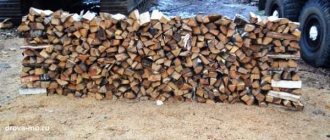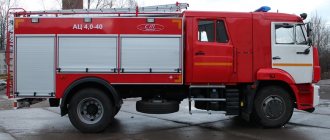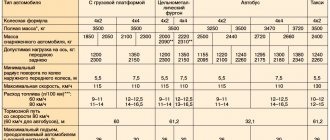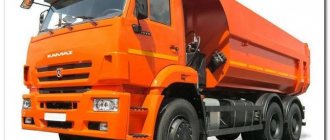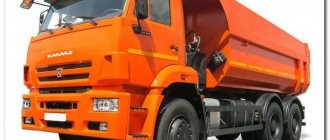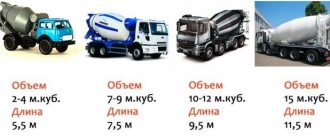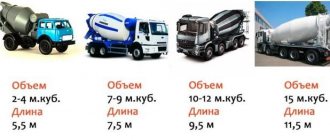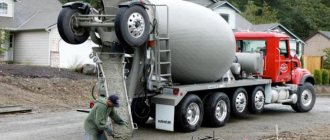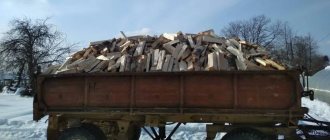Author: Vyacheslav Belyaev, published 11/29/2016
More articles from the section Answering questions
The Internet is often asked how many cubic meters of firewood a ZIL can hold. But there are no good articles on this topic. We decided to be the first and answer how much can fit in the 130th.
It should be said that there are several modifications of ZIL that are used to transport firewood. This could be the 131st, the flatbed 130th, or the ZIL Boat dump truck marked 555. And the firewood can also be stored in the 554th. This is also a dump truck, but with a regular square body.
In terms of carrying capacity, all vehicles from the plant named after. Likhachev are the same. They take on board up to 5 tons of cargo. If the driver does not spare the car, it will load 6.5 tons. Based on the weight of the wood, we can say that the car can take away 7-8 cubic meters of birch.
All ZIL models have different platform sizes. Accordingly, different amounts of wood fit into them.
Capacity 131
The next car is called ZIL 131. It is an all-terrain vehicle with all-wheel drive. It was intended for the army.
How many cubic meters of wood will fit into this army monster? According to technical data, its platform dimensions are as follows: length 3600 mm, width 2322 mm, height 915 mm. Multiplying the numbers you get – 7.64 m3.
price/practicality rating
Author: Vyacheslav Belyaev, published 11/29/2016
More articles from the section Answering questions
The Internet is often asked how many cubic meters of firewood a ZIL can hold. But there are no good articles on this topic. We decided to be the first and answer how much can fit in the 130th.
It should be said that there are several modifications of ZIL that are used to transport firewood. This could be the 131st, the flatbed 130th, or the ZIL Boat dump truck marked 555. And the firewood can also be stored in the 554th. This is also a dump truck, but with a regular square body.
In terms of carrying capacity, all vehicles from the plant named after. Likhachev are the same. They take on board up to 5 tons of cargo. If the driver does not spare the car, it will load 6.5 tons. Based on the weight of the wood, we can say that the car can take away 7-8 cubic meters of birch.
All ZIL models have different platform sizes. Accordingly, different amounts of wood fit into them.
How many cubic meters of firewood are there in the village?
What is the best wood to buy for a fireplace?
The best firewood is prepared from hardwood. Beech and oak are optimal for burning; you can use acacia, aspen or any fruit tree. Regardless of the choice of firewood, there are several requirements for it: to be dry, not rotten. Some types of wood are not suitable for heating, others have high heat transfer and burn smoothly without sparking. When selecting a suitable wood for the firebox, combustion characteristics are taken into account: Beech and oak are considered “elite firewood”. They burn evenly and brightly. During combustion, a pleasant and even crackle is observed. Beech firewood, in terms of its heat output, has practically no equal. For even burning, the logs need to be well dried. Oak firewood also has similar characteristics. The only drawback of oak is its relatively high cost and the difficulties associated with splitting logs. Oak firewood burns for a long time and produces virtually no smoke. Fruit woods are heated with apple, pear and other wood. The advantage of fruit wood is the pleasant smell that enters the room when burning. It is customary to heat living rooms with firewood from fruit trees. Over time, a persistent aroma of wood appears in the room. Poplar and linden: Poplar is drowned exclusively for decorative purposes. Firewood burns quickly and produces little heat. To heat a room with poplar, you will have to constantly add firewood at intervals of 1-1.5 hours. The situation is approximately similar with linden firewood. The logs burn dimly and quickly and emit virtually no heat or smoke. Alder and aspen firewood have a unique feature. When burning, no smoke or soot is generated. Moreover, the fire formed when burning alder burns away the soot inside the chimney. It is recommended to heat the stove with alder or aspen at least once every few weeks, this way you can prevent the internal cavity of the chimney from becoming overgrown with soot. Deciduous wood - burning hazel, acacia, cherry, birch, convenient due to the simple preparation of raw materials. The firewood splits well. Acacia is distinguished by the intense heat emanating from the coals. Birch firewood burns well even when damp, but it requires monitoring the constant flow of fresh air and draft characteristics. Lack of oxygen leads to the formation of birch tar in large quantities.
Capacity 131
The next car is called ZIL 131. It is an all-terrain vehicle with all-wheel drive. It was intended for the army.
How many cubic meters of wood will fit into this army monster? According to technical data, its platform dimensions are as follows: length 3600 mm, width 2322 mm, height 915 mm. Multiplying the numbers you get – 7.64 m3.
price/practicality rating
There are quite a few modifications of ZIL dump trucks.
The volume of the body can be 4, 5 or 6 cubes, the load capacity is also not the same (depending on the modification).
Coal differs in fraction and density, just like buckets of different sizes (volume).
If we start from general figures, then let’s say a bucket of coal weighs 14 kg (this is with containers, without containers 12.5 kg).
The load capacity of a ZIL dump truck is 5 tons (this is also an example, the load capacity may be different).
Converting tons to kilograms 5 tons = 5000 kilograms.
Divide 5000 by 12.5 = 400 buckets of coal can be transported by such a dump truck.
But this figure is approximate, because the dump trucks of the ZIL family are different and the coal is different.
It is also important to take into account the technical condition of a particular car, as a rule, these are old cars (discontinued, some models were produced before 2002, others were discontinued in the nineties) and the load capacity declared by the manufacturer, they will no longer be able to handle it.
To answer unambiguously, you first need to find out the volume of the dump truck body, and then find out how many buckets there will be.
For example, in the picture there is a ZIL with a small body, it is called a five-ton truck, but again it is possible that it was heaped and the weight and volume there will fluctuate.
To understand the average number, let’s take the average coal sold to the population, its fraction is 1-7 cm and its weight ranges from 1.2 to 1.5 tons per cubic meter.
We get data from this: if the body has five tons, then there are from 4.2 to 3.3 cubic meters.
I think it is possible to measure the body of a car in order to understand how many cubic meters of coal are in the body.
Next, having received the volume, display the weight. Let’s assume there are 4 cubes in the body and a weight of 5 tons, we get a coefficient of 1.25, which is the average.
That is, the cube weighs 1250 kg, and the bucket 12.5 kg.
Next, simple mathematical calculations: 5 tons, divided by 12.5 kg - we get 400 buckets.
But again, how to fill buckets, because coal is not water and you can significantly move away from the figure of 400 buckets in different directions.
In any case, you need to measure and calculate while standing next to the coal machine.
Types of dump trucks
These machines continue to perform their functions even now, more than half a century after their production began. The capacity of the ZIL130 is not so large, but it is good to use for working with railway transport, since the height of its body is equal to the height of the car floor. This feature greatly simplifies the loading and unloading processes.
There are several modifications of ZIL cars:
Model 130 is the most common flatbed vehicle with the following platform sizes:
- length - 3752 mm;
- width - 2326 mm;
- height - 575 mm.
Multiplying these values, the actual volume of the ZIL body is 5.02 m3.
The Model 131 is a four-wheel drive all-terrain vehicle designed for the military. Dimensions: 3600x2322x915 mm.
The actual volume is equal to 7.64 m³.
Model 554 is a long-wheelbase model that provides for unloading on the sides. The capacity of its body is 5 m 3. The short-wheelbase modification model ZIL 555 did not have such an opportunity. Modification 554 is very popular in Russia; this vehicle transports agricultural cargo.
The ZIL 555 dump truck , which has a rounded body, appeared later under the name Boat. Its capacity is smaller than all others, it is only 3 m³.
ZIL-130: history
Before entering public roads, the ZIL-130 has come a long way from development and testing to the release of the first pilot batch. The first steps towards creating a car were taken in 1957. It took Soviet engineers five years and titanic efforts to match the car's power with its performance characteristics and select a suitable power unit.
The first experimental batch of ZIL-130 rolled off the manufacturer's assembly line in 1962. Cars received user recognition only in 1963. Finally, in 1964, mass production of cars began. The production of ZIL-130 continued until 2010 at the Ural Automotive Plant.
Technical characteristics of ZIL-130 dump truck
The long process of selecting a power unit and performance indicators was not in vain for the ZIL-130. The world was presented with a new machine, which earned a diploma at an international exhibition and gained popularity among a wide range of users from the industrial and agricultural sectors.
Engine
ZIL-130 dump trucks use a factory power unit with a V-shaped arrangement of eight cylinders. The carburetor four-stroke engine produces 150 hp. maximum power. The crankshaft rotation speed reaches 3200 rpm. The engine reaches its maximum useful torque at 402 Nm.
The engine displacement is 5996 cm3. The engine cylinder diameter is 100 mm, the piston stroke in the cylinder is 95 mm. The compression ratio stopped at 6.5. The power supply system is a carburetor. The engine's needs are provided by the supply of A-76 fuel from fuel tanks with a volume of 175 liters.
Calculation of body volume for transporting sand
When loading the machine, consider the density of the material. The sand is heavy. The technical characteristics of the ZIL 130 allow the dump truck body volume to be loaded up to a maximum of 5 tons. Sometimes drivers allow loading up to 6.5 tons, knowing that their car has such a technical capability.
How much volume of a ZIL body will sand weighing 5 tons take up?
The density of the sand mass ranges from 1400 to 1800 kg/m3. For calculation, an average value of 1600 kg/m 3 is usually taken.
To prevent overloading the machine, you need to determine how many cubic meters of sand are contained in five tons. To do this you need to perform a simple calculation:
5000:1600 = 3.125 m³, or maximum load:
6500:1600 = 4.063 m³.
The density of sand can be determined more accurately by an experimental method. To do this you need:
- take an ordinary bucket with a capacity of 10 liters, fill it with sand and weigh it;
- weigh the bucket without sand;
- subtract the tare weight from the total weight;
- divide the resulting value by 10 - this will be the density of the sand in t/m³.
In order not to be mistaken in calculating the amount of sand, and to avoid overloading the machine, it is recommended to make calculations with a correction factor. The recommended coefficient value is 1.1–1.3.
Body size ZIL-130 dump truck
- length - 6675 mm;
- front wheel track - 1800 mm;
- rear wheel track - 1790 mm;
- cabin roof height - 2400 mm;
- height along the sides of the cargo platform - 2050 mm;
- wheelbase - 3800 mm;
- tilt angle - 38 degrees;
- turning diameter - 14 m;
- curb weight - 5100 kg;
- load capacity - 9000 kg;
- total weight - 14,100 kg;
- distribution to the front axle - 4200 kg;
- distribution to the rear axle - 9900 kg.
